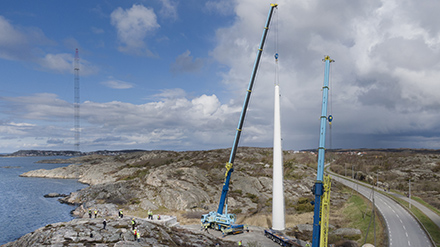Modvion and RWE Renewables Sweden AB are entering a partnership to supply wooden towers to RWE’s future onshore wind farms. The goal with the partnership is to verify the wooden tower technology and prepare for RWE to equip future wind farms with wooden towers, once the towers are available in the market. Source: Timberbiz
As one of the world’s leading companies in renewable energy, RWE has plans to increase its production capacity while reducing its carbon footprint.
“We see that modular towers in laminated wood have significant market potential and can contribute to lowering the cost of new renewable electricity production by replacing steel and concrete with environmentally friendly and climate-smart wood. RWE will be assessing Modvion’s wooden tower for potential use in future wind farms,” said Lars Borisson, Head of Onshore Origination & Development Nordics at RWE Renewables.
Even if steel continues to be used to construct many parts of the wind turbines, wooden towers have the potential to become an important complementary material in tower construction. According to a Sifo survey carried out by Modvion, almost four out of 10 Swedes feel more positive about wind power if the towers are built of wood.
“Our technology can help the wind industry dramatically reduce emissions, while facilitating taller towers to reach stronger winds. It’s great to see leading companies like RWE looking to support innovation that enables renewable energy from renewable materials,” said Maria-Lina Hedlund, CFO and acting CEO at Modvion.
The wind industry wants taller turbines, and Modvion’s patented wind turbine tower provides a cost-effective solution. Laminated wood is stronger than steel proportionate to its weight, which means lighter towers and less need for expensive reinforcements.
The towers are built in modules that can be easily transported, without the need for expensive special transports, road closures and lengthy permit procedures.
Growing trees bind carbon dioxide, which is stored in the wood products that act as a carbon sink. Building using wood enables radical emission reductions compared to conventional materials such as steel and concrete.
“The aim is to further increase the sustainability of wind power. Turbine towers made out of wood have the potential to be an important component in helping the wind power industry become fully carbon neutral. As one of the world’s leading renewable energy companies, this partnership aligns well with RWE’s goal of becoming a carbon-neutral company by 2040,” said Mr Borisson.
Wood is a renewable material that enables radical reductions in emissions. According to a life-cycle analysis from the Swedish research institute RISE, using a wooden tower reduces emissions by 90% when compared to a conventional steel tower of the same height and load. Considering that wood also stores carbon, the tower’s climate impact is actually lower.
“A conventional tower is responsible for the largest portion of emissions that arise from the production of wind turbines. By using wood, the tower becomes carbon negative, storing more carbon than is emitted during production,” said Ms Hedlund.
Modvion will be installing its first commercial wind turbine during 2023. The wooden tower will be installed with a 2-megawatt wind turbine on top and, including the blades, will stand 150 metres tall. Subsequently, Modvion has plans for a 6-megawatt installation, which will be one of the largest turbines used on land.








